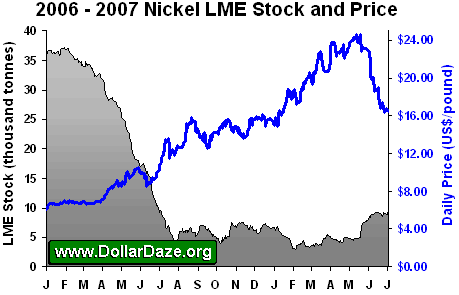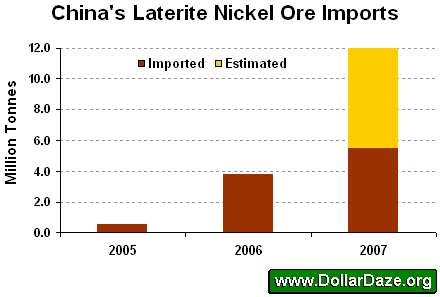What's Happening With The Nickel Market ?
Commodities / Nickel Jul 08, 2007 - 01:43 PM GMTBy: Mike_Hewitt
 Commodity bull markets can often experience a speculative peak followed by a dramatic collapse in price. These sharp peaks are sometimes associated with an attempt to corner the commodity by either a single large entity or collusion of smaller participants. With the exception of DeBeer's which has allegedly been successful at manipulating the diamond market for decades, these activities often end in financial disaster when the aim of the manipulator becomes widely known. They may find themselves becoming the only buyer in order to keep the price high and prevent a catastrophic collapse.
Commodity bull markets can often experience a speculative peak followed by a dramatic collapse in price. These sharp peaks are sometimes associated with an attempt to corner the commodity by either a single large entity or collusion of smaller participants. With the exception of DeBeer's which has allegedly been successful at manipulating the diamond market for decades, these activities often end in financial disaster when the aim of the manipulator becomes widely known. They may find themselves becoming the only buyer in order to keep the price high and prevent a catastrophic collapse.
Cornering the Market
Attempts at cornering the market range from marginally legal to outright fraud such as the Great Salad Oil Swindle of 1963, in which Tino De Angelis attempted to corner the soybean oil market. The famous Hunt Brothers unsuccessfully tried to corner the silver market in 1980, and eventually declared bankruptcy. In 1996, Yasuo Hamanaka, a trader for the Sumitomo Corporation attempted to corner the copper market. The result was an official reported loss of US$2.6 billion for the company and eight years of prison time for Mr. Hamanaka. Much more recently, there were rumours swirling of BP's involvement with the propane market in 2006. During that same year, Amaranth, a large hedge fund, suffered heavy losses after one of its energy traders, Brian Hunter, allegedly attempted to corner the natural gas market.
Although the implementation is difficult and complicated, the principle is quite straightforward and has probably been going on even since there were merchants selling commodities. The idea is to create an artificial shortage by hoarding, thereby allowing the merchant to sell his commodity at a higher cost.
Even in today's sophisticated commodity trading world, the effects on the price by intentional shortages are still amplified should the public perceive a real shortage. There exists some speculation that large institutional traders, such as hedge funds, are presently engaged in similar attempts to corner base metal markets.
This essay will discuss whether this scenario merits any consideration by taking an in-depth look at what is presently occurring with nickel.
Visible and Hidden Metal Stocks
It is practically impossible to measure absolute demand , that being the exact quantity of any particular commodity being consumed by the end consumer. Although somewhat easier, it is still quite difficult to determine how much is being consumed by early stage processes. Take the following example for copper:

 In order to simplify the methodology for measuring commodity demand and supply, analysts use the concept of apparent demand . This is defined for a country as domestic production plus net imports (or minus net exports) adjusted for the change in visible stockpiles. Well-known examples of visible stockpiles would be the London Metals Exchange (LME), the COMEX, or the Shanghai Commodity Index.
In order to simplify the methodology for measuring commodity demand and supply, analysts use the concept of apparent demand . This is defined for a country as domestic production plus net imports (or minus net exports) adjusted for the change in visible stockpiles. Well-known examples of visible stockpiles would be the London Metals Exchange (LME), the COMEX, or the Shanghai Commodity Index.
While this metric has a certain amount of utility, one must always remember that it does not account for build-ups in unreported stockpiles . The accumulation of such stockpiles may be simply for commercial inventory or intentional squeeze operations.
Furthermore, if a large institutional trader is attempting to squeeze the market, they may be purchasing directly from the visible stockpiles. This has the effect of further exacerbating the situation as the public only sees declining stockpiles amidst price increases.
The Nickel Market [1]
Recently, the price of nickel hit $24/pouind amidst effectively zero nickel stockpiles on the LME. The historical mean price for nickel is just over US$4.50/lb.

Was the cause that this high price a result of fundamental changes in the market dynamics for nickel and the recent sell-off presents a spectacular buying opportunity? Or, is it just another squeeze operation and those on the sidelines would be best advised to stay uninvolved?
During nickel's spectacular run-up in price, the mainstream wisdom on Wall Street stated that demand has outstripped supply for nickel due to dramatic increases in Chinese stainless steel production. Last year, there were prolonged labour disputes at Inco's Voisey's Bay and project delays of new major nickel projects such as BHP Billiton's Ravensthorpe mine in Western Australia and Companhia Vale do Rio Doce's (CVRD) Goro nickel project in New Caledonia . The International Nickel Study Group had calculated that the overall market had a 30,000 tonne deficit for 2006 - a figure representing just over 2% of global 1.3-1.4 million tonne annual nickel market.
These arguments collectively form a persuasive argument, but consider what those closely involved with the nickel industry are saying.
Opinion Within the Stainless-Steel Industry
Nickel accounts for 60% of the price of stainless steel and the stainless steel industry accounts for 70% of all nickel demand. Thus, when considering nickel, it is important to consider stainless.
Officials of several stainless steel producers have spoken out against the LME, stating that it is no longer a reliable “mechanism for price discovery”. They believe that large institutional traders are engineering shortages of nickel leaving it vulnerable to rampant price speculation. The following are a selection of quotes made during the large run-up in the price of nickel, as indicated by the news release dates.
China 's largest nickel producing company, the Jinchuan Group, has stated on their official website that, “the LME is no longer a place for fair dealing of metals but a paradise of speculations.” ( Aug 18, 2006 ). It warns customers “not to be puzzled by deceptive information of nickel stock, conditions of supply and demand, as well as price released irresponsibly by a few foreign agencies.” ( Mar 28, 2007 )
David Humphries, chief economist for MMC Norilsk Nickel, the world's largest producer of nickel, said hedge funds had moved in for the kill, triggering a violent “short squeeze” on the futures markets. Those caught with open bets on lower prices are being forced to cover by purchasing the metal, fuelling a blow-off price spike. “For many of those contributing to current prices, it's just a financial play.” ( Apr 06, 2007 ).
“Nickel prices are at unsustainable levels and if they were to remain there we would start to see value destruction in the stainless steel market, which would affect demand,” said Colin Steyn, head of Australia's LionOre ( Apr 06, 2007 ).
Horng-Sheng Sheu, the Senior General Manager of Taiwan 's Walsin Lihwa Corporation, stated that, “[t]he LME has become a big casino.” ( May 22, 2007 )
Yet amidst these statements, the price of nickel rose dramatically amidst low LME nickel metal stockpiles. Furthermore, there have been numerous reports of increasing and significant nickel production from China .
Rising Nickel Production from China
Beijing 's Antaike Information Co. , which advises the Chinese government on metal policies, forecasts China 's nickel output to rise up to 190,000-200,000 tonnes in 2007, up from 140,000 tonnes produced in 2006. This rise is attributed to China 's increasing use of laterite-type nickel ore from the Philippines , Indonesia and New Caledonia .
Laterite is a red-coloured surface material resulting from weathering. It is typically found in abundance in the tropics. Nickel was first produced from laterites from Pointe Chaleix, New Caledonia in 1879. The discovery of nickel sulfides in the Sudbury Basin shifted the focus of nickel mining and, by 1950, almost all global nickel production came from nickel sulfides. Renewed interest in laterites materialized again in the late-1960's. During the 1968/69 strike at Inco's Sudbury mine, the price spiked to US$7/lb (equivalent to US$37.50/lb in 2007 dollars)!
The result was the development of many new laterite mining operations between 1971 and 1986. Production from these mines added a potential capacity of 211,000 tonnes (equivalent to 42% of the Western World's 1970 capacity). Of this amount, only about 150,000 tonnes was ever realized. [2]
Up until recently, while 72% of the world's land-based nickel resources are contained in laterite ore, it only amounted to 42% of world nickel production. [3]
However, starting near the end of 2005, China began imparting increasingly larger quantities of laterites to produce nickel.

It is estimated that China produced around 90,000 tonnes of nickel pig iron in 2006, due to hundreds of small blast furnaces taking up the smelting of nickel instead of iron ore. This production of nickel pig iron had virtually no capital cost, as these furnaces were idle due to legislation cracking down on iron ore smelting citing pollution and uneconomical use of coal.
China's nickel ore imports for 2007 may exceed 12 million tonnes, enough to produce 100,000 tonnes of nickel.”
The majority (~60%) of this laterite comes from the Philippines and typically grades 0.9% to 1.1% nickel. The ore from New Caledonia and Indonesia grade 1.44% and 1.61% respectively. [4]
China is also investing US$775 million this year to develop the controversial Ramu Nickel laterite deposit in Papua New Guinea.
There are also rumours that Japan may soon also begin importing laterites to produce nickel.
Other Worldwide Increases to Nickel Production
High nickel prices have sparked traditional nickel producers to ramp up production from conventional sources by as much as 3-4%. CVRD, produces about one sixth of global market production last year and expects to add 3% to global nickel output over the next five years.
A recent report by Deutsche Bank estimates that CVRD Inco has “numerous” projects on the exploration front which could nearly double nickel output from the current 280,000t/y to a rate of more than 520,000t/y through the next decade.
Australia's commodity forecaster Abare Monday raised Australia's nickel production outlook by 16% to 230,000 tonnes for the fiscal year ending June 30, 2008, as two new mines are expected to come online. Allegiance's Avebury Mine in Tasmania is scheduled to start production in late 2007 with a capacity of 8,500 tons annually, and BHP Billiton's Ravensthorpe project with a capacity of 50,000 tons will be commissioned in early 2008.
An official from the Russian Industry and Energy Ministry announced that Russia could increase 2007 nickel production by 1.1% .
Substitution and Permanent Demand Destruction
High spikes in commodity markets can result in demand destruction. This occurs when the high cost of a base material prompts manufacturers to invest capital into new technologies.
Mark Lim, the Chairman of the Malaysian Iron & Steel Industry Federation, told Reuters that about 20% of 304 stainless steel has been substituted by lower-nickel 200 series stainless. The 200 series was developed in the past few years by Indian mills to conserve nickel. These grades contain about half of the 8% nickel content found in 304 and exhibit less corrosion resistance.
More importantly, fabricators are moving towards ferritic grades – nickel-free stainless steel, known as the 400 series. Steel mills in Japan and South Korea are trying to improve the lower-priced ferritic grade stainless. One ongoing concern with these grades is that they exhibit less toughness, especially in the welded condition, when compared to nickel-containing (or austenitic ) stainless steel.
Posco of South Korea, a large steel manufacturer, has recently announced that it will use 14% less nickel in its stainless production this year as it turns to non-nickel bearing stainless alternatives. Posco has developed and introduced a new process for developing nickel-free stainless with superior properties than existing non-nickel bearing stainless. Other stainless steel producers may follow.
Conclusion
The recent dramatic fall in the price of nickel may be indicative of a real surplus in nickel stockpiles that has been ongoing for some time. Nickel supply/demand calculations fail to include hidden stockpiles due to the complexity of measuring their quantity. Large institutional traders could utilize this oversight to build large commercial inventories thereby. This creates artificial demand on the public stockyards and causes an underestimation of the actual world nickel supply amidst a price increase. The recent price spike to US$24/lb may have been engineered by such a scenario.
This high price spike for nickel has impacted both the supply and demand side of the nickel industry.
China has dramatically increased their nickel production from 59.8 thousand tonnes in 2005 to an anticipated 200,000 tonnes in 2007 through the use of imported laterite ore. China's nickel imports may slow in 2007, or even possibly reverse course from this recent development.
Massive new nickel projects, such as Ambatovy (60kT/yr), Goro (60kT/yr) and Ravensthorpe (50kT/yr) are anticipated to soon go into production. These new mines, in addition to expansions at existing mines will significantly increase nickel supply.
On the demand side, many stainless steel manufactures, representing the largest single demand source for nickel, have made changes to their production to utilize less nickel because of the recent price spike. Some of these changes include high capital costs outlays and will result in permanent demand destruction such as introduction of processes to produce nickel-free 400 series stainless steel.
All of these factors, if accurate, will result in a large inventory build of nickel that will unavoidably make its way to the public stockpile yards despite any activities of metal hoarding. The unfolding of such a scenario would result in a complete reversal in market perception regarding the supply and demand dynamics for nickel.
References
1. ^ For a greater in-depth look at nickel and the presentation which initiated my research for this commentary see Part One of Frank Veneroso's speech to Global Central Bankers at the World Bank (April 17, 2007) here .
2. ^ Dalvi et al ., The Past and the Future of Nickel Laterites , 2004. The development of many energy intensive projects were discontinued during the rapid rise of oil rate in late-1973.
3. ^ Ibid . , In 1950 it is estimated that less than 10% (~140,000 tonnes) of nickel came from laterite sources. The average rate of increase for worldwide nickel production from all sources has been 4% per year.
4. ^ Ibid . , Indonesia is the source of the richest Nickel Laterite at 1.61%, followed by Central and South America at 1.51%. Those of Australia are the lowest at 0.86%.
By Mike Hewitt
http://www.dollardaze.org
Mike Hewitt is the editor of www.DollarDaze.org , a website pertaining to commentary on the instability of the global fiat monetary system and investment strategies on mining companies.
Disclaimer: The opinions expressed above are not intended to be taken as investment advice. It is to be taken as opinion only and I encourage you to complete your own due diligence when making an investment decision.
Mike Hewitt Archive |
© 2005-2022 http://www.MarketOracle.co.uk - The Market Oracle is a FREE Daily Financial Markets Analysis & Forecasting online publication.


